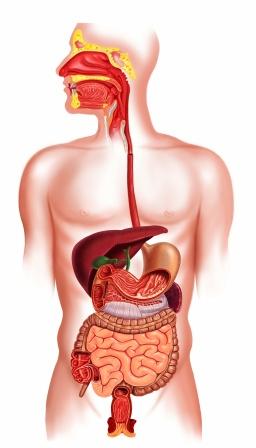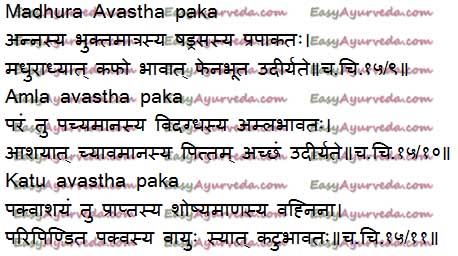Formation Of Doshas In Avastha Paka
By Dr Raghuram Y. S. MD (Ay) & Dr Manasa, B. A. M. S
The three doshas i. e. vata, pitta and kapha are formed and balanced by food we take. All these three doshas are formed at various stages of digestion of food. Read – Understanding Digestion Process From An Ayurveda View
Table of Contents
Introduction

Kapha is formed at beginning part of digestion, in stomach. Pitta is formed at middle phase of digestion, in small intestines. Vata is formed at end part of digestion of food, in colon.
Point of doubt
When doshas are formed at time of our conception in mother’s womb, when dosha predominance makes our basic physical constitution and body type, we get a doubt so as to how food forms and nurtures doshas? Read – Prakriti – Ayurveda Body Types, Importance In Treatment And Remedies
There is no doubt that we carry dosha predominance in our constitution and we inherit them right from moment of conception. There is also no doubt that doshas already exist in our body right from beginning of our lives. But these doshas are functional entities of our system. They are used and done during day long activities. They may go out of balance while getting involved in lot of activities in body. They may also undergo proportional, qualitative and quantitative imbalance, not only individually but also in comparison to other doshas.
Consider our bank account. We spend and we need to replace to maintain balance. Fuel in our vehicles too explains same logic.
The doshas are always there in body, but they keep undergoing imbalances. They need to be supported and brought back to balance for functions of body to run smoothly. Food that we take during various phases of digestion helps in formation of doshas. Foods we take regularly and subsequently keep nurturing and balancing doshas in body. Read – Importance Of Diet (Pathya) For Specific Diseases
Different stages of digestion
Different stages of digestion and formation of doshas from food
Avasta pak is name given for phase wise digestion of food in Ayurveda. Term also explains different parts of alimentary tract wherein different stages of digestion of food take place. Immaterial of taste of food consumed, food acquires in first phase of digestion, sour taste during second phase of digestion and pungent taste in final stage of digestion. These tastes lead to formation of kapha, pitta and vata in stomach, intestine and colon respectively.
During these phases of digestion, doshas are formed and nourished. Doshas enriched in their places also support their subtypes located in other places of body. Read – Types Of Doshas And Their Functions
Formation of Kapha
In first stage of digestion, food acquires sweet taste. Therefore it is called madhura avastha pak i. e. sweet phase of digestion of food. This phase takes place in stomach. Due to sweetness of food, kapha is formed in stomach. This happens because sweet taste supports kapha dosha. In this phase food is partly digested. Later this sweetened food is pushed into intestine, duodenum to be precise, for further digestion. Read – Six Tastes Of Ayurveda: Qualities, Benefits, Therapeutic Action (Shad Rasa)
Formation of pitta
In second stage of digestion, food acquires sour taste. Therefore it is called amla avastha pakam i. e. sour phase of digestion of food. This phase takes place in small intestine. Due to sourness of food, pitta is formed in stomach. This happens because sour taste invariably increases pitta. In this phase food is almost digested. Later this soured food is pushed into large intestine, for residual processing. Read – Bitter Taste – Qualities, Health Benefits, Side Effects
Formation of vata
In second final stage of digestion, food acquires pungent taste. Therefore it is called katu avasthapaka i. e. pungent phase of digestion of food. This phase takes place in colon. Due to pungent nature of food, vata is formed in stomach. This happens because pungent taste invariably increases vata. In this phase almost completely digested food which is propelled from small intestine is dried and converted into hard mass by effect of pungent environment and drying action of vata. In later stages, feces are formed and expelled from body. Read – Pungent Taste – Qualities, Health Benefits, Side Effects
Related organs
A note on seats and organs related to avastha paka in relation to modern anatomy and physiology
The sweet phase of digestion is said to take place in stomach and sour phase of digestion to take place in small intestine. Last part of digestion i. e. pungent phase is said to take place in large intestine. But when we look at modern anatomy and physiology, large colon is not a digestive organ. No digestion of food takes place in colon. It is only that residue water, minerals and salts are absorbed into colon. Later faeces is formed and excreted. Read – Eating Etiquette: Healthy Eating Rules
The term pakwashaya mentioned in context of pungent phase of digestion is large intestine going with ayurvedic translation. Ayurveda also has said solidification of digested food which can be nothing but faeces. Pungent taste and environment produced can be compared to gases and fart which is produced due to chemical process and action of bacterial flora on food in colon. This justifies colon as place of pungent phase of digestion. Read – Involvement Of Doshas In Formation Of Organs
If avastha paka means stage wise digestion of food, colon cannot be considered in strict terms. This is because no digestion takes place in colon.
Therefore taking into consideration digestive zones of alimentary tract, and also considering ayurvedic term paka as digestion, many scholars of ayurveda conclude that –
- Sweet phase of digestion takes place in upper part of stomach
- Sour phase of digestion takes place in lower part of stomach and first part of small intestine i. e. duodenum
- Pungent phase of digestion takes place in lower part of small intestine i. e. jejunum and ileum
Alternatively three phases of digestion can be understood as –
- First phase begins in mouth and completes in upper stomach. First half of food stay in stomach, getting prepared for first part of digestion, getting mixed with mucus and being converted into a bolus can be considered.
- Second phase begins in lower part of stomach and later part of stay of food in stomach wherein it is partially digested; being acted upon by acids can be considered. This phase also continues in duodenum wherein food mixed with acids propelled from lower stomach is acted upon by digestive enzymes including bile, pancreatic juice etc.
- Third and last phase of digestion begins in second part of small intestine i. e. jejunum and ends in large colon. Absorption of essence of digested food takes place in small intestine and absorption of residue water, salts and minerals take place in colon with solidification of waste products and formation of feces and flatus.
Vipaka – Tridosha
Effect of Vipaka on three doshas
Vipaka or nishta paka means post digestion change in taste. Read –Vipaka: Taste Conversion During And After Digestion
When substances we consume, especially medicinal herbs, come into contact with digestive fire and gets digested by it, they undergo change in their tastes. This post digestion change in taste of a substance is called vipaka.
- Substances of sweet and salt tastes get converted into sweet after-taste. This is called madhura vipaka. This will increase kapha.
- Substances of sour taste get converted into sour after-taste. This is called amla vipaka. This will increase pitta.
- Substances of pungent, bitter and astringent tastes get converted into pungent after-taste. This is called katu vipaka. This will increase vata.
Thus, after-tastes will have a similar impact on doshas as in 3 phases of digestion. Read – Normal And Abnormal Dosha Imbalance – Prakrita, Vaikrita Dosha Dushti
Sanskrit verse

Kapha Dosha formation
Formation of kapha dosha from food during first phase of digestion, sweet phase
First phase of digestion of food is called madhura avastha paka.
Madhura = sweet Avastha = stage Paka = digestion
Thus, first stage of digestion is called ‘ sweet phase’ because all foods are converted into a sweet component in stomach. Immaterial of taste of food taken, they will be converted into sweet taste. All six tastes are converted into sweet taste at end of this phase. Read – Why Kids Like Sweets? Why Acidity Starts After 30? Ayurveda Answers
When we take food, we chew food in mouth. Here bodhaka kapha i.e. saliva is mixed with food. Softened masticated food is taken to stomach. In stomach, due to addition of kledaka kapha, local subtype of kapha in stomach, food acquires more sweet taste. Kapha, by nature is sweet. When two subtypes of kapha get added to food, it is obvious that food gains sweetness.
When more sweetness is produced in food added with churning movements of stomach, lot of foam is formed. As a result, kapha is formed in stomach. Thus at end of sweet phase of digestion, foamy kapha is formed.
Sweet taste, among six tastes is kapha increasing taste. Therefore kapha is formed from sweet taste. This kapha helps in development of strength, stamina and endurance of body. Read – Understand Kapha Dosha By Its Functions
Salient features of sweet phase of digestion
- This part of digestion begins in mouth with mastication and ends with moistening of food in stomach leading to formation of foam and kapha.
- In mouth due to mastication and mixture of saliva, sweetness predominantly manifests in food subduing all other tastes.
- Due to admixture of mucus in stomach, food further gets sweetened, becomes foamy and kapha is formed.
- All foods are converted into sweet taste immaterial of taste. But foods rich in sweet, sour and salt tastes give rise to more sweetness and more kapha in stomach. Foods which are unctuous, slimy, liquid, and kapha enhancing foods too have similar impact.
- If one takes food predominant in pungent, bitter, and astringent tastes, less sweet is manifested in food and less kapha is formed in first stage of digestion.
- Kapha also increases in other kapha sites in presence of excessive sweet food in stomach, at least for first 1.5-2 hours after consumption of food. Chakrapani tells that kapha and sweetness in predominant in body zones above level of heart, sweetness and kapha further gets enhanced in these zones during first stage of digestion. We know that kapha zone is located above level of heart.
- This kapha not only supports kapha sites but also gives strength to entire body.
- More sweetness and more kapha is formed in first phase of digestion on consuming sweet rich foods, kapha favouring seasons and food taken in earlier part of day, like breakfast.
- Kapha formed during first stage reduces acidity in stomach and intestines, acts like a buffer and secures these organs. Since pitta is formed in second stage of digestion and lot of sourness is produced in intestines, sweetened food with kapha effect which moves into intestines will antagonize ill effects of sourness and corrosive action of pitta.
- If person is having kapha related disorders, they may temporarily aggravate during this period.
Read – 11 Ayurvedic eating tips for good health
Pitta Dosha formation
Formation of pitta dosha from food during first phase of digestion, sour phase
Second stage of digestion is called amla avastha paka.
Amla = sour Avastha = stage Paka = digestion
Second phase of digestion is called ‘sour phase’ because food acquires sour taste in this phase. At end of sweet phase of digestion, semi digested food which has acquired sweetness is propelled down from stomach into small intestine, duodenum to be precise. Read – Ayurvedic Pitta Diet – food suitable for Pitta body type
Once food comes to intestine it becomes sour, losing its sweet nature carried from first phase of digestion. This happens due to contact and admixture of food with sour materials present in intestine. Pitta is basically present in this organ and this causes sourness in organ.
Due to sourness and as an impact of action of pachaka pitta i. e. digestive pitta, food gets partly digested. Since stomach has propelled food which is digested to a small extent, food is further more digested in small intestine, lower part of stomach and duodenum to be precise.
Sourness produced in intestine will form and support pitta located in this organ. Due to prevailing sourness, achcha pitta or dilute pitta gets discharged into intestine from its walls, i. e. pitta is formed due to sourness caused in food in second phase of digestion i. e. intestinal digestion.
This can be compared to action of acids and enzymes on food in duodenum and stomach. Most of food gets digested in this phase.
Sour taste, among six tastes is predominant pitta increasing taste. Therefore pitta is formed from sour taste or sourness created in food in second phase of digestion. Other tastes remain latent. This pitta which is formed will support other pitta subtypes located in body and will enable proper gut and cellular metabolism.
Salient features of sour phase of digestion
- This part of digestion begins after sweet phase of digestion taking place in stomach i. e. after completion of first phase of digestion. Following events would be reception of partly digested sweetened foods from stomach, action of pitta on food causing semi digestion of food, formation of sourness in food and formation of pitta due to prevailing sourness in intestine. Second phase ends when sour food is emptied from small intestine into large intestine and with onset of third phase of digestion in colon.
- In intestine, which is seat of digestive fire located in form of pitta, due to action of sourness naturally prevailing in intestine, organ being pitta place, sourness predominantly manifests in food. It is just like sourness enveloping food. Food loses its sweetness inherited from stomach, and gains sourness. Other tastes are subdued.
- Due to increased sourness, pitta is stimulated and its dilute form is released into intestine. This marks production of pitta by prevailing sourness. Thus, sourness of food forms pitta and this pitta is supported and nurtured further. Pitta maintains sourness of intestines and sourness of food in second phase of digestion once again produces and supports pitta, this cycle is rhythmic and natural unless disturbed by pathological processes.
- As a rule, sweetened food coming from stomach into intestine during this phase gets influenced and enveloped by sourness and gets sour form. Foods rich in pungent, sour and salt tastes gives rise to more pitta at end of this phase. But if person has consumed foods which are rich in sweet, bitter and astringent tastes or cold foods, less pitta is formed. Foods which are hot, unctuous, intense, deep penetrating, light and liquid also enhance pitta.
- Pitta also increases in other pitta sites in presence of excessive sour food in intestine. Chakrapani tells that pitta and sourness is natural and predominant in body zone between heart and navel, sourness and pitta further gets enhanced in these zones during second stage of digestion. We know that pitta zone is located between navel and heart, navel being chief and governing centre for pitta.
- This pitta not only supports pitta sites but also manages metabolism in entire body.
- More sourness and more pitta is formed in second phase of digestion on consuming sour rich foods, pitta favouring seasons and food taken in afternoon, like lunch.
- If person is having pitta related disorders, they may temporarily aggravate during this period.
Read – Relationship Between Doshas And Basic Elements (Pancha Mahabhuta)
This pitta should be formed in a proper way and should be balanced. If this pitta goes out of balance it may produce many diseases, mainly inflammatory in origin. Increased pitta also may aggravate already existing pitta disorders. Knowledge of this formation, balance and imbalance of pitta in relation to phases of food digestion will help physicians in helping patients to balance their pitta and also to administer suitable interventions when pitta imbalance takes place.
Vata formation
Formation of vata dosha from food during final phase of digestion, pungent phase
Third stage of digestion is called katu avastha paka.
Katu = pungent Avastha = stage Paka = digestion
Thus, end stage of digestion is called ‘ pungent phase’ because all foods are converted into a pungent component in large intestine. At end of sour phase of digestion, food which has been almost digested and has acquired sourness is propelled down from small intestine into large intestine. Read – Vata Dosha – Qualities, Functions, Imbalance – Charaka Sutrasthana 12
After second phase of digestion, digested food is pushed from small intestine into colon by action of vata. Due to action of drying fire located in large intestine, sour food loses most of its moisture and attains a solid form. It is in this site that feces are formed, after all essential ingredients including water has been totally absorbed by colon walls following drying action on food by local fire.
Food which has come into colon with sourness it had acquired in small intestine would lose its sourness here due to change in composition and in course of getting converted into a hard mass, ready to be expelled from body in form of feces or an important metabolic waste. Read – Apana Vata Location, Functions, Imbalance Symptoms, Treatment
Food not only loses its sourness but also gains pungent taste due to changes it undergoes in colon. Due to enhanced pungent nature of large intestine, vayu is formed. It is clearly known that colon is chief site and governing seat of vata. Vata already exists here. But pungent nature of food stimulates vata and helps it to be enriched. Vata is not only stimulated and enriched; it is also supported by pungent food.
This pungent phase of digestion and formation of vata can be compared to post-digestion changes occurring in digested food entering colon. Here water and salts are reabsorbed into system. Digested food is converted into feces and is later eliminated from body when defecation reflex arises. Read – Importance of Stool (Faeces) in Ayurveda – Physiology, Pathology
Pungent taste, among six tastes is predominant vata increasing taste. Therefore vata is formed from pungent taste acquired by food in third and last phase of digestion. Other tastes remain latent. This vata which is formed will support other vata subtypes located in body and will enable soft running of all body activities.
Salient features of pungent phase of digestion
- Pungent phase of digestion begins after completion of sour phase of digestion in intestines, i. e. after completion of second part of digestion in which most food is digested. Events that would follow include reception of soured and almost digested food after sour phase of digestion from small intestine, action of colon fire and vayu on food, subsequent conversion of food into hard mass with little moisture, formation of pungent taste in food, manifestation of pungent environment in large gut and resultant formation and nurture of vata. This is final phase of digestion. Though digestion doesn’t take place in true sense in this phase, digested food is depleted of its water and useful contents, which are absorbed into system through colon walls, stools are formed and expelled at end of this phase. Thus, this phase ends where feces is formed, reaches rectum and gets ready to get excreted following manifestation of defecation reflex.
- In colon, which is prime seat of vata, due to effect of pungent environment naturally prevailing in large intestine and due to formation of hard mass of food, and also as an effect of changes taking place in large gut, food loses sourness it had carried from small intestine and acquires pungent taste. Other tastes get subdued.
- In colon, due to increased pungent nature prevailing in organ and pungent taste which develops in food, vata is stimulated and formed. Thus pungent nature of food forms and supports vata. Vata thus formed maintains pungent environment in colon. Sourness of food in this end stage of digestion once again produces vata and supports it. This takes place in a cyclic way in normal circumstances.
- As a rule, sour food coming from stomach into large intestine during this end phase of digestion gets influenced and enveloped by pungent taste and gets pungent form. Foods rich in pungent, bitter and astringent tastes, cold and dry in nature, light foods give rise to more vata at end of this phase. But if person has consumed foods which are rich in sweet, sour and salt, hot and unctuous foods, less vata is formed since these tastes and qualities are antagonistic to those of vata.
- Vayu also increases in other vata sites in presence of excessive pungent food in colon. Chakrapani tells that vata and pungent is natural and predominant in body zone below navel, pungent taste and vata further gets enhanced in this zone during final stage of digestion. We know that vata zone is located below navel, mainly colon, colon being chief and governing center for vata.
- This vata not only supports other vata sites but also manages to balance all activities occurring in body, since vata is controller of all functions of body.
- More pungent environment and more vata is formed in third phase of digestion on consuming pungent rich foods, vata favouring seasons and food taken in evening, like dinner.
- If person is having vata related disorders, they may temporarily aggravate during this period.
As a part of this digestion process, this vata should be formed in a proper way and should be balanced. If this vata goes out of balance it may produce many diseases, mainly degenerative in origin. increased vata also may aggravate already existing vata disorders. This knowledge of formation, balance and imbalance of vata in relation to final phase of food digestion will help physicians in helping patients to balance their vata and also to administer suitable medicines, treatments, dietetic and lifestyle changes when vata imbalance takes place.
Click to Consult Dr Raghuram Y. S. MD (Ayu) – Email / Skype











2 comments
Santhosh kumar
Dear sir,
Good information Sir. What is that makes the sourness of food in amla avastha pak and pungency of food in katu avastha pak? As it is said bodhaka kapha and kledhaka kapha forms sweetness of food in stomach.
Thank you
Dr J V Hebbar MD(Ayu)Author
Pachaka Pitta, at the level of intestines, is responsible to turn the food into sour, during Amla Avastha Paka.
Apana Vata is responsible for the Katu Avastha Paka at the level of large intestines.